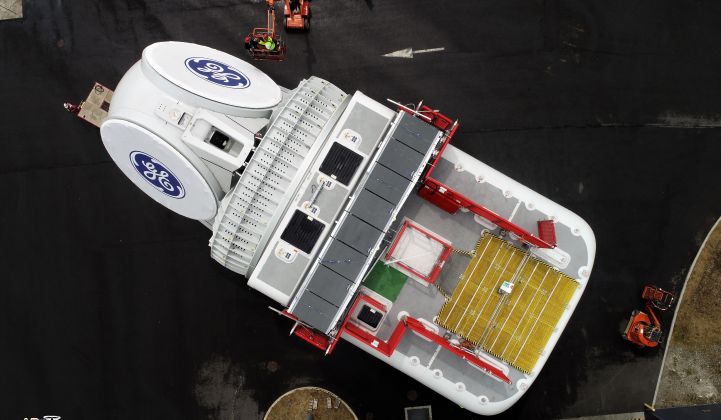The first orders for GE’s groundbreaking 12-megawatt Haliade-X offshore wind turbine have come from the industrial giant's home country, with developer Ørsted planning to deploy more than 1,200 megawatts of the machines in U.S. waters between 2022 and 2024.
GE on Thursday announced it has secured “preferred turbine supplier” status for Ørsted’s 120-megawatt Skipjack and 1,100-megawatt Ocean Wind projects, scheduled for completion off Maryland and New Jersey in 2022 and 2024. Both projects have offtake contracts in place.
The turbines and blades will be manufactured at GE's facilities in France and transported to the project sites.
The deal represents a critical vote of confidence in GE’s fledgling offshore wind business, which unveiled the Haliade-X concept only last year in a bid to crack the current offshore wind duopoly of Siemens Gamesa and MHI Vestas outside China. Real-world testing of the Haliade-X is set to begin this year, and even with its smaller existing model, GE's track record in offshore wind is comparably short.
Even so, offshore wind is one of the most important growth businesses for GE's standalone Renewable Energy division as the global onshore wind market matures. Wood Mackenzie expects offshore wind to blossom into a multi-gigawatt annual market in the U.S. by 2024, led by New York and New Jersey, but with Massachusetts, Connecticut and Maryland all playing significant roles through the 2020s.
The deal "means a lot" for GE’s offshore wind ambitions, especially coming from market leader Ørsted, GE’s offshore wind CEO John Lavelle said in an interview. "Gaining the confidence of Ørsted after the very long due diligence process that they go through. [...] It's a big day."
In a July interview, Shashi Barla, WoodMac's principal analyst covering the global wind supply chain and technology, said Haliade-X will be a "game-changer" for offshore wind — if GE manages to control the costs.
Rapidly scaling market
The U.S. offshore wind market is not scaling up along a normal path for a renewable technology, as GE's order highlights. Project sizes are set to jump from Block Island's 30 megawatts to multi-hundred-megawatts with nothing in between, in a market with virtually no existing supply chain.
New York recently jumped its offshore wind target to 9 gigawatts by 2035, making the technology a centerpiece of the state's push to rapidly decarbonize its grid.
While Haliade-X is the largest turbine for which orders are being placed today, WoodMac expects 16-megawatt machines to be installed in U.S. waters by the end of the 2020s and product lines to include turbines of up to 20 megawatts.
Momentum in U.S. offshore wind appeared to hit a speed bump this summer when the federal government delayed issuing a key permit for Vineyard Wind's 800-megawatt contracted project off Massachusetts, slated to use MHI Vestas turbines.
But Lavelle shrugged off the possibility of bigger concerns for the market. "Project by project, you'll have challenges along the way," he said. "But at the macro level, there's a lot of inertia and support for offshore wind in all the states in the Northeastern U.S."
An Ørsted-orchestrated supply chain
Ørsted now controls more than half of the U.S. offshore wind pipeline, giving it huge influence over the development of the nascent supply chain.
In July, Ørsted named Siemens Gamesa the conditional supplier of 1.7 gigawatts of its 8-megawatt turbines for a trio of projects — Sunrise Wind, Revolution and South Fork — that will deliver electricity into New York, Rhode Island and Connecticut.
Maryland, where the Skipjack project will sell its power, has some of the most stringent local-content requirements in place within the U.S. offshore market — and some of the highest offshore wind prices to match. In July, Ørsted announced it will establish an offshore wind staging area within the Tradepoint Atlantic facility near Baltimore to bring jobs to the state.
Meanwhile, Ørsted plans to establish a manufacturing facility for foundations in Paulsboro, New Jersey with German partner EEW.
Although offshore wind turbine nacelles and blades are expected to be made at European facilities and brought to the U.S. for the foreseeable future, the steadily growing project pipeline could draw a manufacturer eager to be the first mover.
"The best way to grow jobs is by having the projects; then the jobs will come," Lavelle said.
***
Wood Mackenzie is hosting an invite-only analyst briefing on the U.S. offshore wind sector in Boston the morning of Wednesday, October 23. Email [email protected] to express interest in attending.




